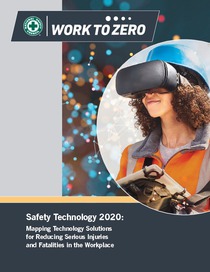Safety technology 2020: mapping technology solutions for reducing serious Iijuries and fatalities in the workplace

National Safety Council, Itasca
NSC - Itasca
2020
43 p.
occupational accidents ; fatalities ; prevention ; technology ; occupational risks ; analysis of accident causes ; robots
Occupational accidents
English
Bibliogr.;Ill.
"The goal of the Work to Zero initiative at the National Safety Council (NSC) is to eliminate workplace fatalities through the use of technology. Based on existing data, expert insight and feedback from environmental, health and safety (EHS) professionals, NSC identified the top eighteen hazardous workplace situations (e.g., work at height, confined space entry, machinery operation) and associated situational risks (e.g., falls, struck by, arc flash) that account for the greatest amount of workplace fatalities across different industries, job types and worker activities.
Next, NSC identified the systemic contributing factors (e.g., lack of training, fatigue, poor equipment design) that sometimes exacerbate risk within those same hazardous situations. NSC also identified a list of over one hundred relevant EHS technologies that could help mitigate both the situational and systemic risks and mapped these technologies to the risks in ways that the surveyed EHS professionals perceived to be most effective.
The top hazardous situations were work at height, workplace violence, and repair and maintenance tasks. The most used safety technologies were robotics (e.g., drones), sensors/detectors (e.g., radio–frequency ID sensors) and software (e.g., control of work software). EHS technology adoption criteria and barriers are also discussed. Future Work to Zero studies will examine the effectiveness of specific EHS technologies at reducing serious injury and fatality risk exposure and develop best practices for new technology adoption and implementation for reducing workplace fatalities."
Digital
The ETUI is co-funded by the European Union. Views and opinions expressed are however those of the author(s) only and do not necessarily reflect those of the European Union or the ETUI.